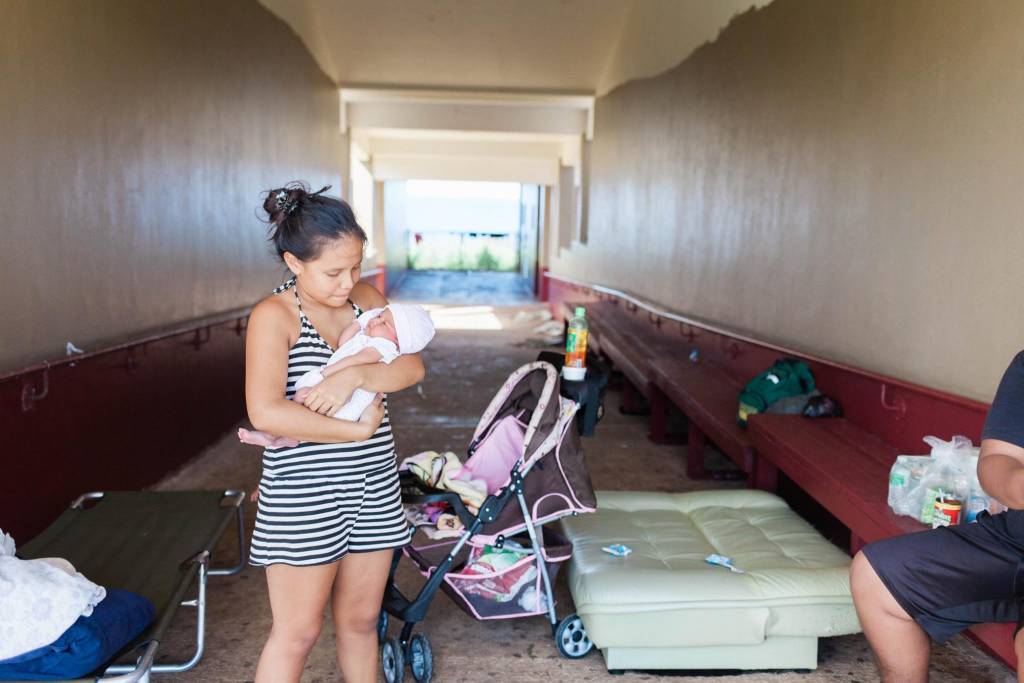We delivered drinking water today as we have every day since the day after the typhoon. Today, our group alone delivered nearly 5000 gallons out to the villagers, 5 gallons at a time. The best part of the day was when, in a village called Tanapag, three elderly women rolled a big laundry basket down the street with empty bottles to be filled at our truck. I put the full bottles back in the basket for them and they collectively pushed it back up the road to their apartment building. Behind them, and headed in the opposite direction was a 6 year old boy and his sister, rolling their water bottles down the road to what was left of their house. Is water collection, the most important task of all, the duty of the young and the elderly?
– Margaret Rose, resident of Saipan
On August 2nd, the most powerful storm of 2015 wreaked havoc upon Saipan, in the Northern Mariana Islands of the Western Pacific. It then continued on its path across Taiwan and China, making thousands homeless, claiming dozens of victims and setting a long path to recovery. You can see the wreckage in Saipan in the video below here.
https://www.youtube.com/watch?v=mcZS3EwT_go
A week after the event, I reached out to 350.org supporters in Saipan to see how they are responding and coping. As people have responded to my email, it has become evident that the response of people on the ground in Saipan is a lesson in self-led community organising. People are stepping up to meet urgent needs and working together to make sure everyone is taken care of.
Here’s how they are organising – thanks to a reply from Rebecca Skeele:
A group of citizens have formed a group that has grown into a grassroots volunteer group providing access to water and other essential necessities for people affected by the storm. We are driving into the back roads of villages and getting these necessities to families who have lost everything and so far have not been able to access relief from either the government or other larger NGOs.
Our group is called United 4 Saipan. Our volunteers are posting stories of the people they have encountered and the challenges they are facing during the recovery process. As part of this group, photographer Lauren Benson has set up a Facebook page called Humans of Saipan: Typhoon Soudelor in which she shares photos of families in our community who have been most affected, in particular those families who have taken refuge at the shelters around the island. Thank you for thinking of us and our tiny island.

Daelina and Shota have lived on island their entire life. Daelina graduated high school in 2013 and 2 weeks ago gave birth to a beautiful baby girl. During the typhoon, these two young parents retreated to Kagman High School where they have been sleeping on cots with their family. They are facing shortage of diapers as well as sanitation supplies. Photo thanks to Humans of Saipan: Typhoon Soudelor.
I recently took on a new role within 350.org to develop the programme for how we respond to climate change impacts. This work is high stakes: we are at the intersection of a century increasingly defined by a rapidly warming world, and that’s colliding with the sheer number of people populating it. There’s more people more vulnerable to the dramatic and dangerous changes that come with a warming world. This is a dangerous century. So it’s important that we get the response right, and to get it right, it has to be led from the grassroots alongside governments and big relief agencies – like it has been in Saipan, and like it was in Vanuatu following Cyclone Pam earlier this year. We can learn a lot from these experiences, as well as carry great hope, because it shows the strength of our capacity to care for each other in times of need.
You can support the recovery efforts in Saipan by donating to the crowdfunder here.
Typhoon/Cyclone/Hurricane intensity and climate change
While the correlation between climate change and typhoons is complex, we know that climate change is making typhoons more intense. This is how Carbonbrief explained the contribution climate change made to Cyclone Pam in Vanuatu:
Vanuatu frequently experiences cyclones. The cyclone season runs from December to April when the weather in the region is hot and wet. Tropical storms derive energy from the warmth of the ocean and convert it into wind strength.
While strong storms aren’t unusual for the region, Cyclone Pam was exceptional. Prof Kevin Trenberth, expert in climate change and extreme weather at the US National Centre for Atmospheric Research, tells Carbon Brief:
“In the large area around Vanuatu the sea surface temperatures were one to two degrees Celsius above normal … So the atmosphere all around there has some 10 to 20% more moisture in it than a comparable storm in the 1970s would have had.”
Some, but not all, of the extra warming can be pinned on human activity, Trenberth adds. Much of it is a result of a weak El Niño event in the Pacific Ocean. He says:
“[A]bout 0.6 degrees Celsius can be blamed on human-induced global warming and that means over one degree is “natural” and associated with a weak El Niño.”
While we can’t control the natural contribution from El Niño, we can control just how much human-induced warming happens. So as much as we need to respond with humanity to the impacts of climate change, we also need to be fighting to keep fossil fuels in the ground. If we do that right, it’ll save a lot of future destruction and loss.
To the people of Saipan, Taiwan and China affected by Typhoon Soudelor, our thoughts are with you!